前文简单提到模板匹配中的一种:NCC多角度模板匹配,博主结合实际的检测项目(已落地)发现其准确率和稳定性有待提升,特别是一些复杂背景的图形,又或是模板选取不当都会造成不理想的效果;同时也借鉴过基于梯度变化的匹配策略,但要说落实到实际项目上去总是差强人意(可能也是鄙人技术不够,哈哈);所以博主今天分享另外两种比较适用的匹配方式!
1). 当图像中存在完整且容易提取的外形轮廓时,shapematch形状匹配不失为一种简单快捷的方法,不需要额外去按照固定角度旋转图像来搜索图像,亦不需要担心模板图像旋转后的留白区域影响匹配得分,按照固定的模式来操作即可: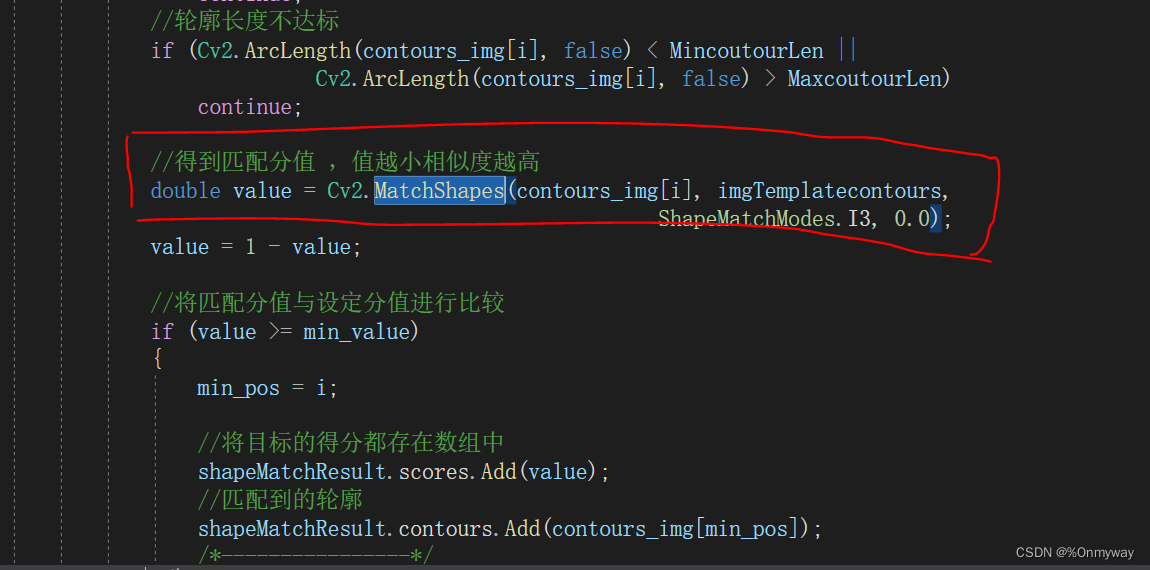
使用Opencv已有方法MatchShapes进行匹配即可,不过匹配后的重心和角度 需要做进一步处理,重心计算公式:
//获取重心点
Moments M = Cv2.Moments(bestcontour);
double cX = (M.M10 / M.M00);
double cY = (M.M01 / M.M00);
角度计算公式:
//-90~90度
//由于先验目标最小包围矩形是长方形
//因此最小包围矩形的中心和重心的向量夹角为旋转
RotatedRect rect_template = Cv2.MinAreaRect(imgTemplatecontours);
RotatedRect rect_search = Cv2.MinAreaRect(bestcontour);
//两个旋转矩阵是否同向
float sign = (rect_template.Size.Width - rect_template.Size.Height) *
(rect_search.Size.Width - rect_search.Size.Height);
float angle=0;
if (sign > 0)
// 可以直接相减
angle = rect_search.Angle - rect_template.Angle;
else
angle = (90 + rect_search.Angle) - rect_template.Angle;
if (angle > 90)
angle -= 180;
测试效果如下:
0度:
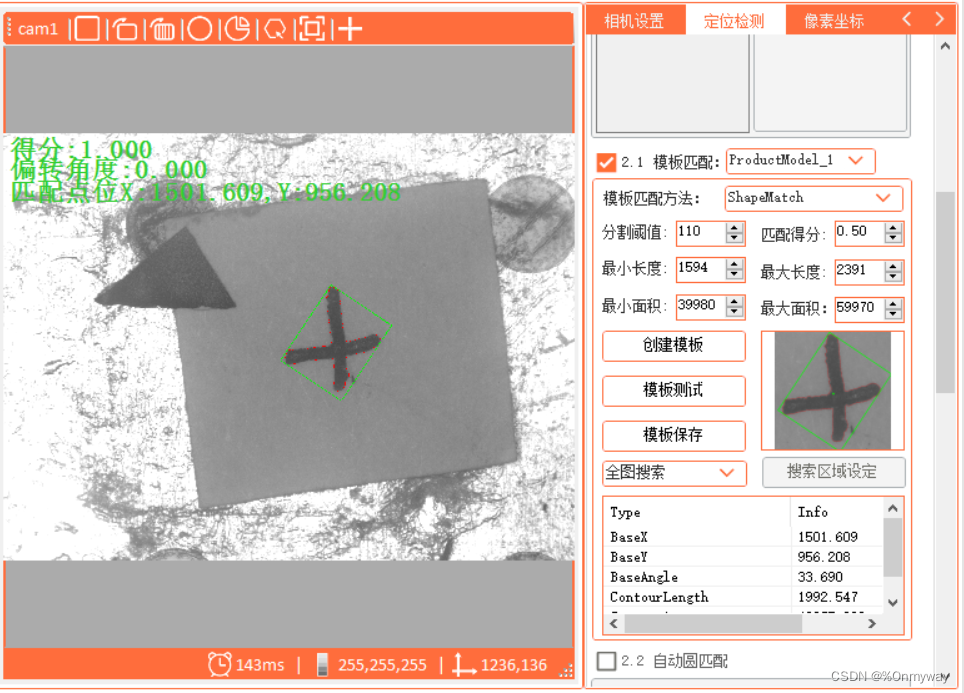
-30度:
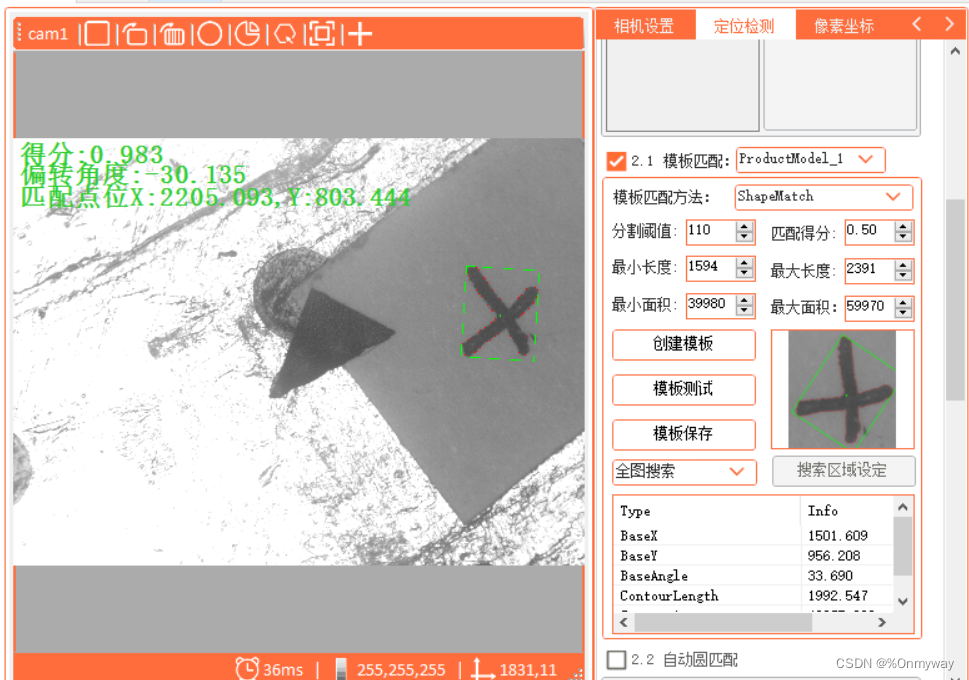
50度:
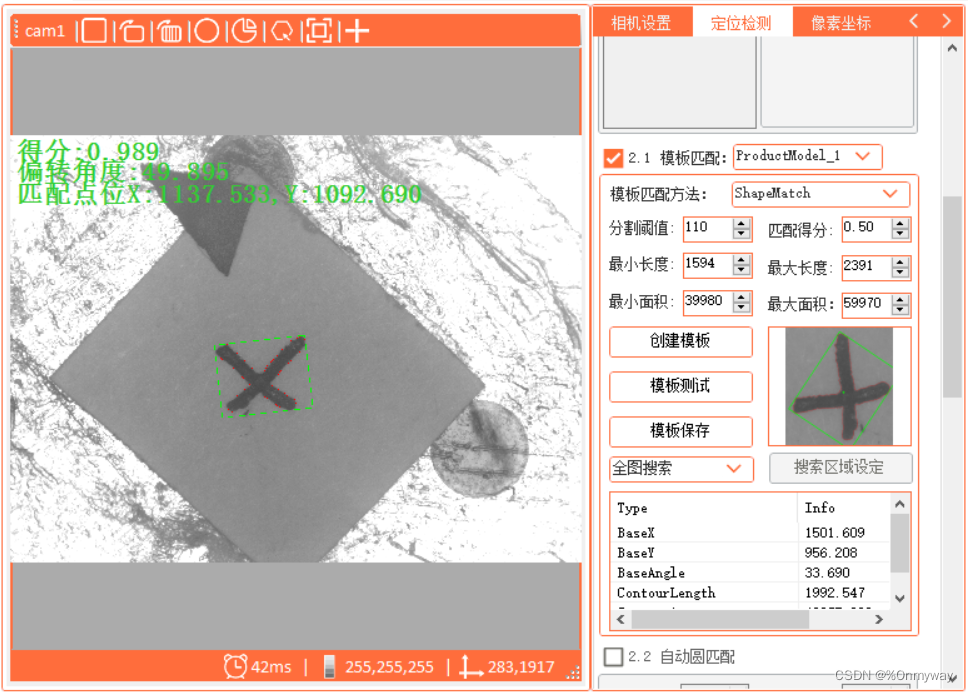
如同为shapematch形状匹配方式,测试时间约40毫秒左右,当然这个也会与图像大小与轮廓大小相关,不管也可以通过构建金字塔模型来加快搜索速度。
2). 下面来针对**NCC归一化模板匹配**做一下简单说明,NCC有几种不同的匹配模式,分别为:

关键的匹配方法如下:
for (int i = 0; i <= (int)range / step; i++)
{
newtemplate = ImageRotate(model, start + step * i, ref rotatedRect, ref mask);
if (newtemplate.Width > src.Width || newtemplate.Height > src.Height)
continue;
Cv2.MatchTemplate(src, newtemplate, result, matchMode, mask);
Cv2.MinMaxLoc(result, out double minval, out double maxval, out CVPoint minloc, out CVPoint maxloc, new Mat());
if (double.IsInfinity(maxval))
{
Cv2.MatchTemplate(src, newtemplate, result, TemplateMatchModes.CCorrNormed, mask);
Cv2.MinMaxLoc(result, out minval, out maxval, out minloc, out maxloc, new Mat());
}
if (maxval > temp)
{
location = maxloc;
temp = maxval;
angle = start + step * i;
modelrrect = rotatedRect;
}
}
为了提高匹配速度,可使用金字塔下采样-》上采样来完成:
//对模板图像和待检测图像分别进行图像金字塔下采样
for (int i = 0; i < numLevels; i++)
{
Cv2.PyrDown(src, src, new Size(src.Cols / 2, src.Rows / 2));
Cv2.PyrDown(model, model, new Size(model.Cols / 2, model.Rows / 2));
}
Rect cropRegion = new CVRect(0, 0, 0, 0);
for (int j = numLevels - 1; j >= 0; j--)
{
//为了提升速度,直接上采样到最底层
for (int i = 0; i < numLevels; i++)
{
Cv2.PyrUp(src, src, new Size(src.Cols * 2,
src.Rows * 2));//下一层,放大2倍
Cv2.PyrUp(model, model, new Size(model.Cols * 2,
model.Rows * 2));//下一层,放大2倍
}
location.X *= (int)Math.Pow(2, numLevels);
location.Y *= (int)Math.Pow(2, numLevels);
modelrrect = new RotatedRect(new Point2f((float)(modelrrect.Center.X * Math.Pow(2, numLevels)),//下一层,放大2倍
(float)(modelrrect.Center.Y * Math.Pow(2, numLevels))),
new Size2f(modelrrect.Size.Width * Math.Pow(2, numLevels),
modelrrect.Size.Height * Math.Pow(2, numLevels)), 0);
CVPoint cenP = new CVPoint(location.X + modelrrect.Center.X,
location.Y + modelrrect.Center.Y);//投影到下一层的匹配点位中心
int startX = cenP.X - model.Width;
int startY = cenP.Y - model.Height;
int endX = cenP.X + model.Width;
int endY = cenP.Y + model.Height;
cropRegion = new CVRect(startX, startY, endX - startX, endY - startY);
cropRegion = cropRegion.Intersect(new CVRect(0, 0, src.Width, src.Height));
Mat newSrc = MatExtension.Crop_Mask_Mat(src, cropRegion);
//每下一层金字塔,角度间隔减少2倍
step = 2;
//角度开始和范围
range = 20;
start = angle - 10;
bool testFlag = false;
for (int k = 0; k <= (int)range / step; k++)
{
newtemplate = ImageRotate(model, start + step * k, ref rotatedRect, ref mask);
if (newtemplate.Width > newSrc.Width || newtemplate.Height > newSrc.Height)
continue;
Cv2.MatchTemplate(newSrc, newtemplate, result, TemplateMatchModes.CCoeffNormed, mask);
Cv2.MinMaxLoc(result, out double minval, out double maxval,
out CVPoint minloc, out CVPoint maxloc, new Mat());
if (double.IsInfinity(maxval))
{
Cv2.MatchTemplate(src, newtemplate, result, TemplateMatchModes.CCorrNormed, mask);
Cv2.MinMaxLoc(result, out minval, out maxval, out minloc, out maxloc, new Mat());
}
if (maxval > temp)
{
//局部坐标
location.X = maxloc.X;
location.Y = maxloc.Y;
temp = maxval;
angle = start + step * k;
//局部坐标
modelrrect = rotatedRect;
testFlag = true;
}
}
if (testFlag)
{
//局部坐标--》整体坐标
location.X += cropRegion.X;
location.Y += cropRegion.Y;
}
}
为了提高匹配得分,当图片与模板都进行一定角度旋转后,会产生无效区域,影响匹配效果,此时我们需要创建掩膜图像.
/// <summary>
/// 图像旋转,并获旋转后的图像边界旋转矩形
/// </summary>
/// <param name="image"></param>
/// <param name="angle"></param>
/// <param name="imgBounding"></param>
/// <returns></returns>
public static Mat ImageRotate(Mat image, double angle,ref RotatedRect imgBounding,ref Mat maskMat)
{
Mat newImg = new Mat();
Point2f pt = new Point2f((float)image.Cols / 2, (float)image.Rows / 2);
Mat M = Cv2.GetRotationMatrix2D(pt, -angle, 1.0);
var mIndex = M.GetGenericIndexer<double>();
double cos = Math.Abs(mIndex[0, 0]);
double sin = Math.Abs(mIndex[0, 1]);
int nW = (int)((image.Height * sin) + (image.Width * cos));
int nH = (int)((image.Height * cos) + (image.Width * sin));
mIndex[0, 2] += (nW / 2) - pt.X;
mIndex[1, 2] += (nH / 2) - pt.Y;
Cv2.WarpAffine(image, newImg, M, new CVSize(nW, nH));
//获取图像边界旋转矩形
Rect rect = new CVRect(0, 0, image.Width, image.Height);
Point2f[] srcPoint2Fs = new Point2f[4]
{
new Point2f(rect.Left,rect.Top),
new Point2f (rect.Right,rect.Top),
new Point2f (rect.Right,rect.Bottom),
new Point2f (rect.Left,rect.Bottom)
};
Point2f[] boundaryPoints = new Point2f[4];
var A = M.Get<double>(0, 0);
var B = M.Get<double>(0, 1);
var C = M.Get<double>(0, 2); //Tx
var D = M.Get<double>(1, 0);
var E = M.Get<double>(1, 1);
var F = M.Get<double>(1, 2); //Ty
for(int i=0;i<4;i++)
{
boundaryPoints[i].X = (float)((A * srcPoint2Fs[i].X) + (B * srcPoint2Fs[i].Y) + C);
boundaryPoints[i].Y = (float)((D * srcPoint2Fs[i].X) + (E * srcPoint2Fs[i].Y) + F);
if (boundaryPoints[i].X < 0)
boundaryPoints[i].X = 0;
else if (boundaryPoints[i].X > nW)
boundaryPoints[i].X = nW;
if (boundaryPoints[i].Y < 0)
boundaryPoints[i].Y = 0;
else if (boundaryPoints[i].Y > nH)
boundaryPoints[i].Y = nH;
}
Point2f cenP = new Point2f((boundaryPoints[0].X + boundaryPoints[2].X) / 2,
(boundaryPoints[0].Y + boundaryPoints[2].Y) / 2);
double ang = angle;
double width1=Math.Sqrt(Math.Pow(boundaryPoints[0].X- boundaryPoints[1].X ,2)+
Math.Pow(boundaryPoints[0].Y - boundaryPoints[1].Y,2));
double width2 = Math.Sqrt(Math.Pow(boundaryPoints[0].X - boundaryPoints[3].X, 2) +
Math.Pow(boundaryPoints[0].Y - boundaryPoints[3].Y, 2));
//double width = width1 > width2 ? width1 : width2;
//double height = width1 > width2 ? width2 : width1;
imgBounding = new RotatedRect(cenP, new Size2f(width1, width2), (float)ang);
Mat mask = new Mat(newImg.Size(), MatType.CV_8UC3, Scalar.Black);
mask.DrawRotatedRect(imgBounding, Scalar.White, 1);
Cv2.FloodFill(mask, new CVPoint(imgBounding.Center.X, imgBounding.Center.Y), Scalar.White);
// mask.ConvertTo(mask, MatType.CV_8UC1);
//mask.CopyTo(maskMat);
//掩膜复制给maskMat
Cv2.CvtColor(mask, maskMat, ColorConversionCodes.BGR2GRAY);
Mat _maskRoI = new Mat();
Cv2.CvtColor(mask, _maskRoI, ColorConversionCodes.BGR2GRAY);
Mat buf = new Mat();
//# 黑白反转
Cv2.BitwiseNot(_maskRoI, buf);
Mat dst = new Mat();
Cv2.BitwiseAnd(newImg, newImg, dst, _maskRoI);
//Mat dst2 = new Mat();
//Cv2.BitwiseOr(buf, dst, dst2);
return dst;
}
这个时候准备工作就完成的差不多,当然关于匹配精度(亚像素处理)这个地方就不做说明了,参考前文即可。测试的效果图如下:
0度:
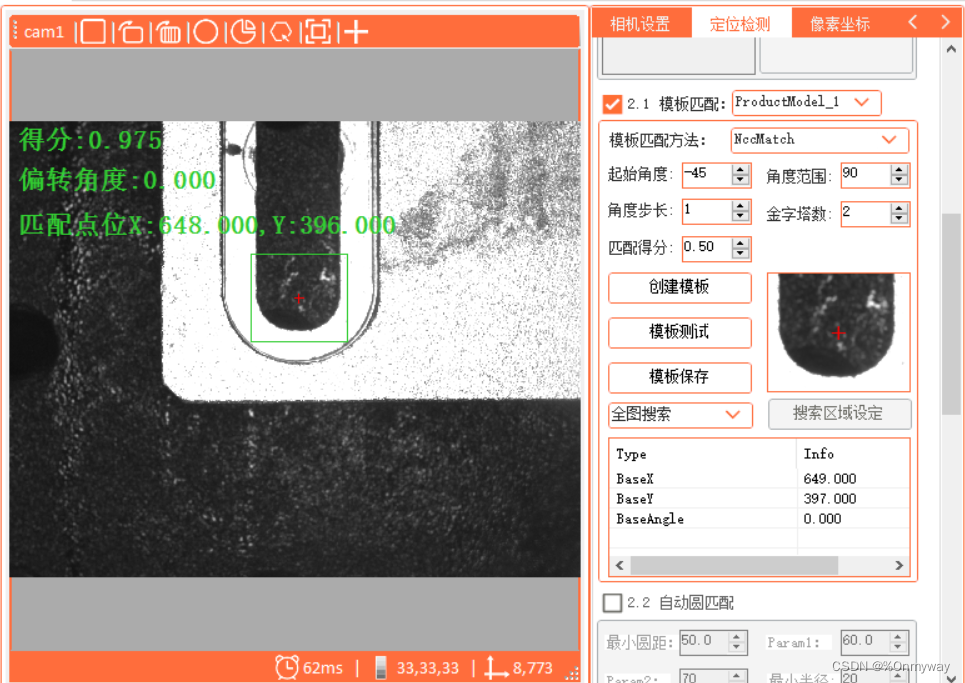
25度:

-35度:
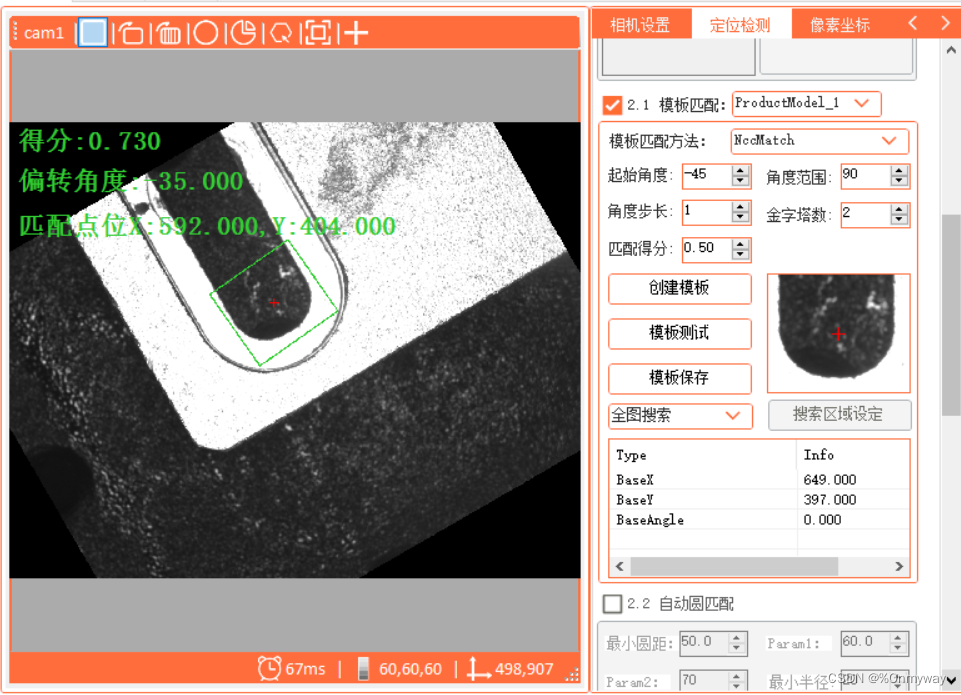
3). 在NCC模式的基础上,同是结合shapematch,衍生出另外一种匹配方式:canny模板匹配,大家可以理解为先创捷canny图模板,然后再使用MatchTemplate方法,同时加入金字塔搜索策略。
创建Canny模板:
/// <summary>
/// 创建Canny模板图像
/// </summary>
/// <param name="src"></param>
/// <param name="RegionaRect"></param>
/// <param name="thresh"></param>
/// <param name="temCannyMat"></param>
/// <returns></returns>
public Mat CreateTemplateCanny(Mat src,Rect RegionaRect,double thresh,ref Mat temCannyMat,
ref double modelX, ref double modelY)
{
Mat ModelMat = MatExtension.Crop_Mask_Mat(src, RegionaRect);
Mat Morphological = Morphological_Proces.MorphologyEx(ModelMat, MorphShapes.Rect,
new OpenCvSharp.Size(3, 3), MorphTypes.Open);
Mat binMat = new Mat();
Cv2.Threshold(Morphological, binMat, thresh, 255, ThresholdTypes.Binary);
temCannyMat = EdgeTool.Canny(binMat, 50, 240);
Mat dst = ModelMat.CvtColor(ColorConversionCodes.GRAY2BGR);
CVPoint cenP = new CVPoint(RegionaRect.Width / 2,
RegionaRect.Height / 2);
modelX = RegionaRect.X + RegionaRect.Width / 2;
modelY = RegionaRect.Y + RegionaRect.Height / 2;
Console.WriteLine(string.Format("模板中心点位:x:{0},y:{1}", RegionaRect.X + RegionaRect.Width / 2,
RegionaRect.Y + RegionaRect.Height / 2));
dst.drawCross(cenP, Scalar.Red, 20, 2);
return dst;
}
模板图:
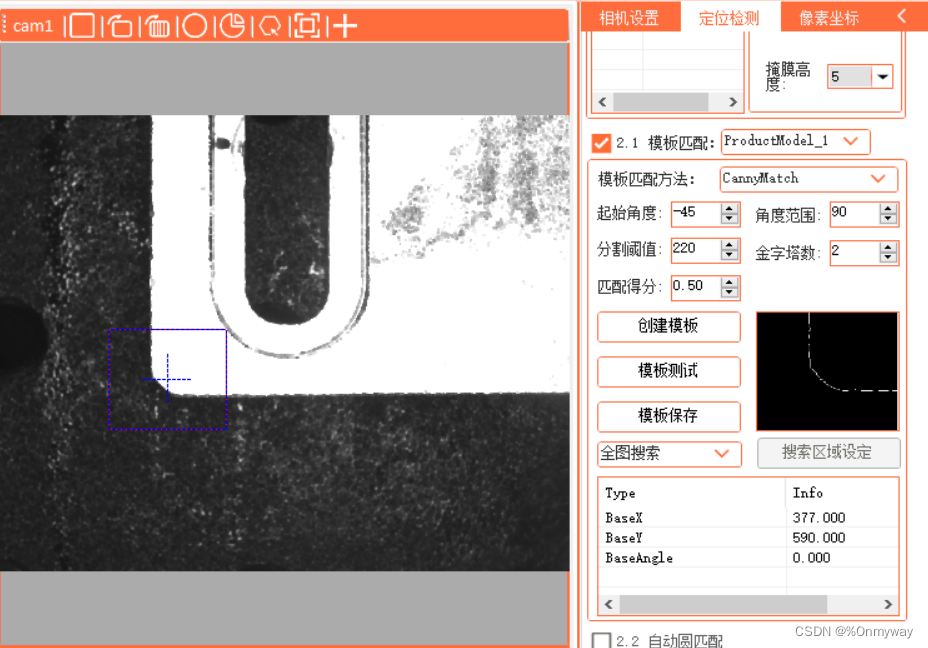
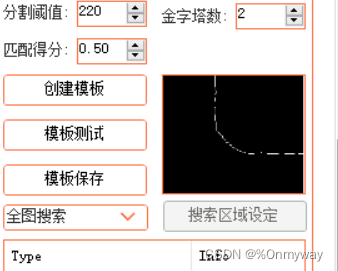
测试效果图如下:

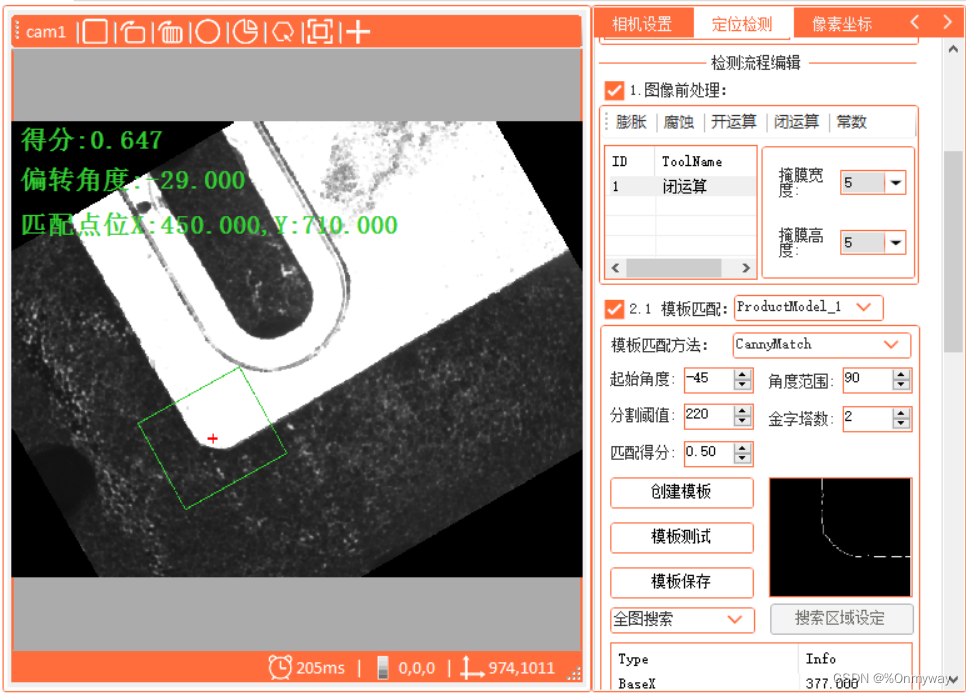
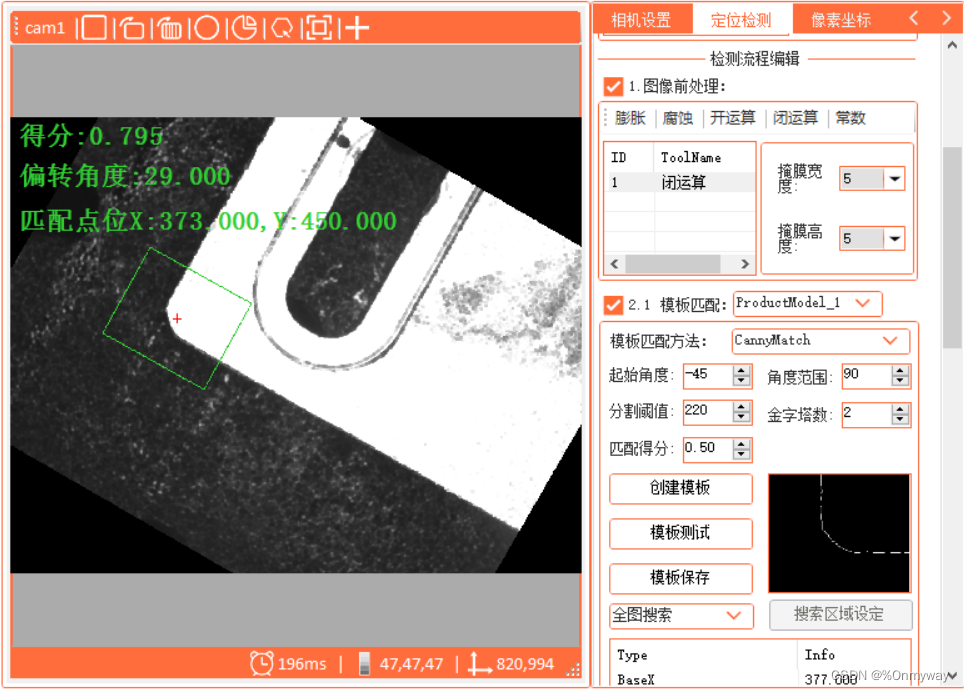
4)通过以上三种对比可发现,它们各有优缺点,shapematch形状匹配强调物体外形的完整性,操作简单,不需要额外构建掩膜和角步循环;NCC不需要选取这个物体来制作模板,只需要前景与背景有一定的区分即可,但是整体匹配效果一般,一些复杂的环境下可能会得不到想要的效果;Canny模板匹配结合了前面2中的部分优点,既可选取物体的局部特征,同时又有NCC匹配方法和策略;大家可以结合实际的项目,选取合适的方法达到最优的效果即可;当然网络上还有一些学术上更优更稳定的方法,如:基于梯度变化的模板匹配,大家也可以尝试一下,反正博主能力有限测试的时候没有达到想要的效果,特别是一些复杂的图像和尺寸较大的图像,测试的结果差强人意,同时实际的项目对于效率的要求也比较高,我们也不可能舍近求远,选择相对合适的即可。同时期待有共同兴趣的大佬们一起来探索发现和指正,大家共同进步。
PS:知识无国界,分享让大家都快乐!
版权归原作者 %Onmyway 所有, 如有侵权,请联系我们删除。